|
Classification of birds encountered in southern Africa
Life
> Eukaryotes >
Opisthokonta
> Metazoa (animals) >
Bilateria >
Deuterostomia > Chordata >
Craniata > Vertebrata (vertebrates) > Gnathostomata (jawed
vertebrates) > Teleostomi (teleost fish) > Osteichthyes (bony fish) > Class:
Sarcopterygii (lobe-finned
fish) > Stegocephalia (terrestrial
vertebrates) > Tetrapoda
(four-legged vertebrates) > Reptiliomorpha > Amniota >
Reptilia (reptiles) >
Romeriida > Diapsida > Archosauromorpha > Archosauria >
Dinosauria
(dinosaurs) > Saurischia > Theropoda (bipedal predatory dinosaurs) >
Coelurosauria > Maniraptora
Based on Hockey et al. (2005).
|
Palaeognathae |
|
|
|
Order: Struthioniformes (Ostrich)
One family, the Struthionidae and only one
living Species indigenous to southern Africa: the Ostrich Struthio
camelus. There is one other living species, the Somali
ostrich Struthio molybdophanes, which occurs in the horn of
Africa. |
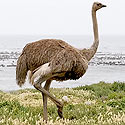 |
|
Gallo-anserae |
|
|
|
Order: Galliformes
(guineafowls, quails, pheasants, francolins, grouse, turkeys)
Two Families indigenous to southern Africa:
Phasianidae (francolins and quail) and
Numididae
(guineafowl)
Species of this order can be found anywhere in the world,
living in a wide range of habitats. They forage on the ground, tending more
to run then fly if disturbed, as their flight is difficult and tiresome for
them. They nest in scrapes in the ground, usually lined with soft material,
laying about 4-20 eggs. The chicks leave the nest immediately once they
hatch, staying close to their mother until they grow independent.
|
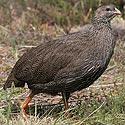 |
|
|
Order: Anseriformes
(ducks, whistling ducks, geese, swans, screamers)
Two Families indigenous to southern Africa: the
Anatidae
(ducks, geese) and the Dendrocygnidae
(whistling ducks).
Ducks and geese are extremely common water birds, and are
found almost everywhere in southern Africa. They live in wetlands of all
types, as well as rivers, streams and estuaries.
|
 |
|
Neoaves |
|
|
|
Order: Turniciformes
(buttonquails)
One family, the Turnicidae. |
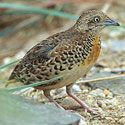 |
|
|
Order: Piciformes
(barbets, honeyguides, woodpeckers, wrynecks, toucans)
Piciformes encompasses a wide variety of birds, most of
which live in woodlands or forests. Honeyguides are the only birds in the
world able to eat beeswax, and are brood parasites, laying their eggs in
other birds nests. Barbets are common in many areas of southern Africa,
feeding mainly on fruit and excavating nests into the underside of dead
branches. Most woodpeckers are adept at clinging on to tree branches, using
their chisel-shaped bills to pick up invertebrates. |
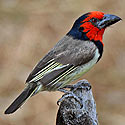 |
|
|
Order: Buceratiformes
(hornbills)
There are two families: the Bucerotidae
(typical hornbills), the females of which seal themselves, using a
mud-like material such as faeces, in in the tree cavity, staying their
until the oldest chick is a few weeks old; and the Bucorvidae, which includes two species, one of
which, the Southern
ground-hornbill Bucorvus leadbeateri, occurs in southern
Africa. This species' eggs hatch in the sequence laid, meaning that the one chick is 3-14
days older than the other chick. The younger chick is unable to compete for
food with its older sibling, and dies of starvation when it is 1, rarely 3-4
weeks old. |
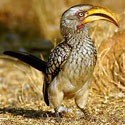 |
|
|
Order: Upupiformes
(hoopoes, wood-hoopoes, scimitarbills)
This order consists of 4 very distinctive birds, which
occur in many areas of southern Africa. Their diet mostly consists of
insects, which are eaten on the ground or in trees. They all nest in
cavities, usually in trees but sometimes in man-made structures, often using the same site repeatedly. The eggs are incubated solely by the female,
with the male doing most of the hunting. The chicks leave the nest at 21-32
days old, but are still dependent on their parents months after fledging. |
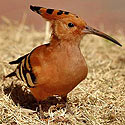 |
|
|
Order: Trogoniformes
(trogons)
One family, the Trogonidae,
in which there is only one Species indigenous to southern Africa, the Narina
trogon Apaloderma narina.
The Narina trogon occurs in Africa south of the Sahel, from Ghana to Ethiopia, extending south to Angola and southern
Africa, where it prefers to live in indigenous forest. It feeds mainly on
invertebrates, such as caterpillars, Spiders and mantids, rarely feeding on
small reptiles. It nests in natural tree cavities, which are notoriously
difficult to find. It lays 2-4 eggs, which are incubated by both sexes, for
16-21 days. The chicks are brooded in the early stages of their life,
staying the nest for 25-28 days. They remain with the parents months after
fledging, even when they can get their own food. |
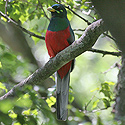 |
|
|
Order: Coraciiformes (kingfishers,
bee-eaters, rollers) Coraciiformes encompasses a wide
variety of bird species - the rollers mainly eat insects, and have a
characteristic "rolling" courtship display. The kingfisher groups are small,
stocky birds with long straight bills, eating exclusively animals, such as
fish, insects and small vertebrates. The bee-eaters, as there name suggests,
mainly eat members of Hymenoptera (bees, wasps and ants), with some species
forming very large colonies, dug into riverbanks and cliffs. |
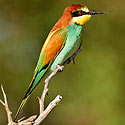
|
|
|
Order: Coliiformes (mousebirds)
One family, Coliidae.
Mousebirds are endemic to Africa, and are common in many areas of
southern Africa, living in a wide range of habitats. They eat mainly fruit,
with the rest of their diet flowers, leaves and buds, amongst others. The
nest is a small cup made of fine plant matter, made by both sexes and
sometimes a helper. They lay 1-7 eggs, which are incubated by both sexes.
The chicks stay in the nest for 10-20 days, after which they become
independent. |
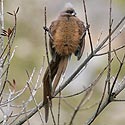 |
|
|
Order: Cuculiformes
(cuckoos and coucals)
Two families: the Cuculidae
(cuckoos) and the Centropodidae
(coucals). Cuckoos and coucals are fairly
common in many areas of southern Africa, and are interesting birds. Coucals
are voracious predators, feeding on mammals, birds and insects, while
cuckoos specialize in eating hairy caterpillars. Interestingly, cuckoos are
brood parasites, laying their eggs in other birds nests. (These birds are
known as hosts) The cuckoo chick usually kills the host's chicks once its
born. Coucals are monogamous solitary nesters, making a large nest out of
grass stems and leaves, with the male doing most of the incubation and
caring for the chicks. |
 |
|
|
Order: Psittaciformes (parrots, parakeet and
lovebirds)
One family, the Psittacidae.
Parrots occur mainly in the northern half of southern Africa, living in wide
variety of habitats. They eat mainly seeds, with smaller amounts of fruit,
nuts and invertebrates. They nest in a wide variety of sites, often in tree
cavities. The incubation is usually done by the female, with the male doing
most of the hunting. The chicks can take months to leave the nest, after
which they are still dependent on their parents for weeks more. |
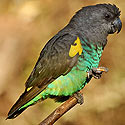 |
|
|
Order: Apodiformes (swifts)
One family in southern Africa, Apodidae.
Swifts occur almost everywhere in the world except remote islands and polar
areas. They are highly adept at flying, and can reach great heights and very
fast speeds, with some species able to reach over 200 km/h! They are
insectivores, eating small, aerial arthropods, always catching them on the
wing. They live in large flocks, making nests of feathers and grass, glued
together with saliva. |
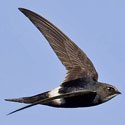 |
| |
Order: Musophagiformes
(turacos / louries)
One family in southern Africa, Musophagidae.
This is 1 of 2 orders endemic to Africa, the other being the
mousebirds. Most turacos live in evergreen
forest, mainly eating plant products, especially fruit. Their nest is a
flimsy platform built of interlacing twigs. They usually lay 2-3 eggs, which
are incubated buy both parents. The chicks leave the nest before they can
fly, and for a few weeks they clamber around in trees, becoming independent
soon after they fledge. |
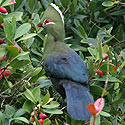 |
|
|
Order: Strigiformes
(owls, nightjars)
Owls and nightjar can be seen anywhere in southern Africa,
with different species having different specializations. They are nocturnal
carnivores, with the large owls feeding on mammals and birds, and the small
owls and nightjars feeding mainly on invertebrates. They do not usually
build their own nest, but rather use shallow holes in the ground, other
birds nests, etc. With owls, the chicks leave the nest for the surrounding
bush, but are still dependent on their parents months after fledging. |
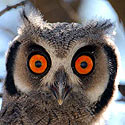
|
|
|
Order: Columbiformes (pigeons and doves)
One family, the Columbidae.
Pigeons and doves can be found everywhere in southern Africa, and are
prolific in most habitats. They mainly eat fruits and seeds, with a small
amount of invertebrates. They usually build their nest out of twigs and
roots, placed in a tree or bush. Usually, 1 or 2 eggs are laid,
which are always incubated by both sexes. The chicks usually stay in the
nest for up to 20 days, after which they become fully
independent. |
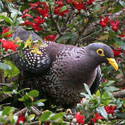 |
|
|
Order: Gruiformes
(cranes, rails, crakes, flufftails, gallinules, moorhens,
coots, finfoots, bustards, korhaans)
|
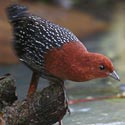
|
|
|
Order: Charadriiformes
(jacanas, oystercatchers, plovers, turnstones, sandpipers, stints, snipe,
curlews, phalaropes, avocets, stilts, dikkops, coursers, pratincoles,
skuas, gulls, terns, skimmers) |
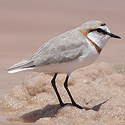 |
|
|
Order: Falconiformes (vultures, kites,
hawks, eagles, buzzards, harriers, Osprey, falcons, kestrels and
Secretarybird) |
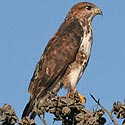
|
|
|
Order: Ciconiiformes
(grebes, tropicbirds, boobies, gannets, anhingas, cormorants, herons,
bitterns, egrets, Hamerkop, flamingos, ibises, spoonbills, pelicans,
Shoebill, New World vultures, condors, storks, frigatebirds, penguins,
divers, storm-petrels, albatrosses, petrels, shearwaters, diving-petrels) |
 |
|
|
Order: Passeriformes
(perching birds) |
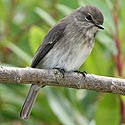 |
References
-
Hockey PAR, Dean WRJ and Ryan PG 2005. Roberts
- Birds of southern Africa, VIIth ed. The Trustees of the John Voelcker
Bird Book Fund, Cape Town.
Text by Hamish and Duncan Robertson
|
